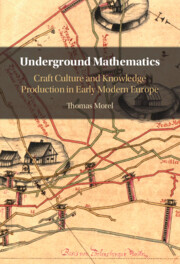Refine search
Actions for selected content:
13588 results in History of science and technology
Bibliography
-
- Book:
- Underground Mathematics
- Published online:
- 08 December 2022
- Print publication:
- 22 December 2022, pp 253-280
-
- Chapter
- Export citation
Index
-
- Book:
- Underground Mathematics
- Published online:
- 08 December 2022
- Print publication:
- 22 December 2022, pp 281-292
-
- Chapter
- Export citation
Introduction
-
- Book:
- Underground Mathematics
- Published online:
- 08 December 2022
- Print publication:
- 22 December 2022, pp 1-19
-
- Chapter
- Export citation
Acknowledgements
-
- Book:
- Underground Mathematics
- Published online:
- 08 December 2022
- Print publication:
- 22 December 2022, pp x-xii
-
- Chapter
- Export citation
7 - ‘One of Geometry’s Nicest Applications’
-
- Book:
- Underground Mathematics
- Published online:
- 08 December 2022
- Print publication:
- 22 December 2022, pp 213-242
-
- Chapter
- Export citation
Copyright page
-
- Book:
- Underground Mathematics
- Published online:
- 08 December 2022
- Print publication:
- 22 December 2022, pp iv-iv
-
- Chapter
- Export citation
2 - A Mathematical Culture
-
- Book:
- Underground Mathematics
- Published online:
- 08 December 2022
- Print publication:
- 22 December 2022, pp 50-82
-
- Chapter
- Export citation
4 - Writing It Down
-
- Book:
- Underground Mathematics
- Published online:
- 08 December 2022
- Print publication:
- 22 December 2022, pp 118-148
-
- Chapter
- Export citation
Stratifying seamanship: sailors’ knowledge and the mechanical arts in eighteenth-century Britain
-
- Journal:
- The British Journal for the History of Science / Volume 56 / Issue 1 / March 2023
- Published online by Cambridge University Press:
- 22 December 2022, pp. 45-63
- Print publication:
- March 2023
-
- Article
-
- You have access
- Open access
- HTML
- Export citation
Contents
-
- Book:
- Underground Mathematics
- Published online:
- 08 December 2022
- Print publication:
- 22 December 2022, pp vii-vii
-
- Chapter
- Export citation
3 - The Mines and the Court
-
- Book:
- Underground Mathematics
- Published online:
- 08 December 2022
- Print publication:
- 22 December 2022, pp 83-117
-
- Chapter
- Export citation
6 - How to Teach It?
-
- Book:
- Underground Mathematics
- Published online:
- 08 December 2022
- Print publication:
- 22 December 2022, pp 183-212
-
- Chapter
- Export citation
Figures
-
- Book:
- Underground Mathematics
- Published online:
- 08 December 2022
- Print publication:
- 22 December 2022, pp viii-ix
-
- Chapter
- Export citation
1 - Of Scholars and Miners
-
- Book:
- Underground Mathematics
- Published online:
- 08 December 2022
- Print publication:
- 22 December 2022, pp 20-49
-
- Chapter
- Export citation
Conclusion
-
- Book:
- Underground Mathematics
- Published online:
- 08 December 2022
- Print publication:
- 22 December 2022, pp 243-252
-
- Chapter
- Export citation
5 - ‘So Fair a Subterraneous City’
-
- Book:
- Underground Mathematics
- Published online:
- 08 December 2022
- Print publication:
- 22 December 2022, pp 149-182
-
- Chapter
- Export citation
Dedication
-
- Book:
- Underground Mathematics
- Published online:
- 08 December 2022
- Print publication:
- 22 December 2022, pp v-vi
-
- Chapter
- Export citation
Commercial television and primate ethology: facial expressions between Granada and London Zoo
-
- Journal:
- The British Journal for the History of Science / Volume 56 / Issue 1 / March 2023
- Published online by Cambridge University Press:
- 19 December 2022, pp. 83-102
- Print publication:
- March 2023
-
- Article
-
- You have access
- Open access
- HTML
- Export citation
Anti-voluntarism, natural providence and miracles in Thomas Burnet's Theory of the Earth
-
- Journal:
- The British Journal for the History of Science / Volume 56 / Issue 1 / March 2023
- Published online by Cambridge University Press:
- 19 December 2022, pp. 1-20
- Print publication:
- March 2023
-
- Article
-
- You have access
- Open access
- HTML
- Export citation

Underground Mathematics
- Craft Culture and Knowledge Production in Early Modern Europe
-
- Published online:
- 08 December 2022
- Print publication:
- 22 December 2022
